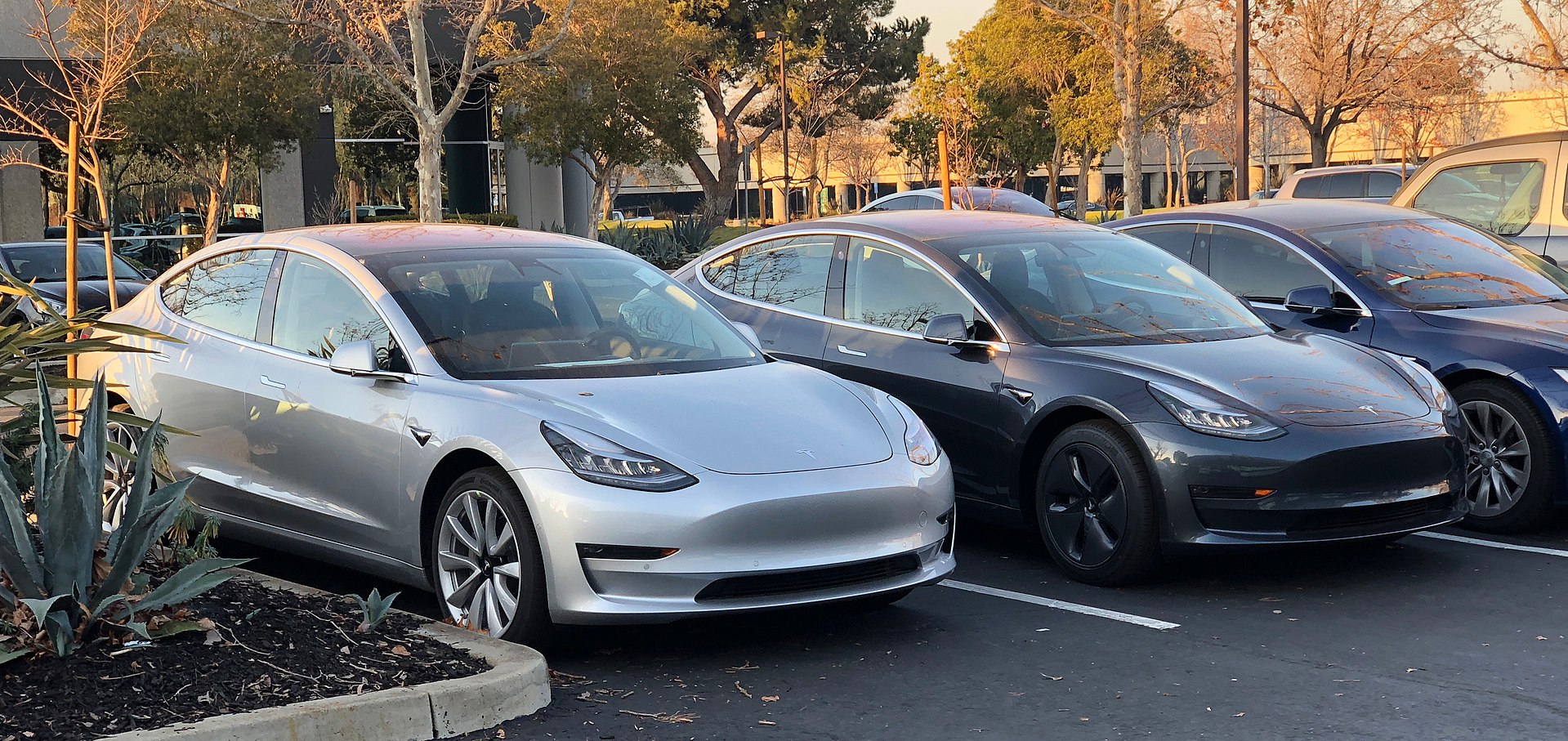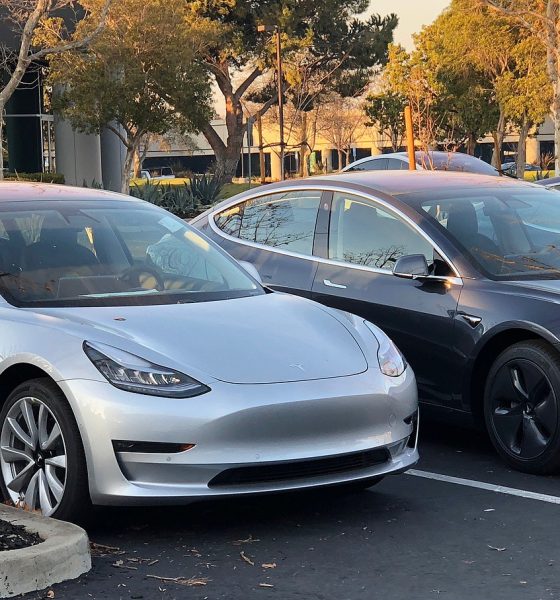

News
Tesla Model 3 production in China is opening doors to a lucrative car-sharing market
Tesla’s plans for China are ambitious, even by the company’s standards. By the end of summer, Tesla expects the initial construction of Gigafactory 3 to be complete, and by year’s end, the company plans to start Model 3 production in the facility. As the dust settles after the groundbreaking ceremony for Gigafactory 3, though, a notable opportunity for Tesla has also presented itself.
China represents the world’s largest auto market, and its EV industry is growing fast. Amidst this growth, the country has also seen the rise of car-sharing services, which provide commuters a way to get from Point A to Point B without the hassles of public transportation or the responsibilities of owning a car. An analysis from the Nikkei Asian Review last year estimated that car-sharing services in China could hire out as many as 2 million vehicles in 2020 — a notable increase from the 100,000 cars used in 2017.
Since CC Clubs, China’s first modern car-sharing company, was launched in 2010, the industry has seen a notable rise. Amidst the government’s initiatives that make car ownership trickier, the presence of car-sharing services was widely appreciated by the commuting public. Over the years, car-sharing services in the country have steadily transitioned to electric vehicles as well, augmented in part by the government’s subsidies in production and sales of EVs, as well as restrictions placed on ICE vehicles in a number of Chinese cities.
In response to this trend, Bloomberg noted that legacy automakers are launching initiatives to catch China’s car-sharing trend. Last April alone, Didi Chuxing, one of China’s most prominent ride-hailing firms, formed an alliance with auto companies such as Volkswagen AG and Toyota Motor Corp. to develop vehicles explicitly designed for car-sharing. Volvo Cars and Geely Automobile Holdings Ltd. have also launched a car-sharing feature for its new models through its joint venture, Lynk & Co.
It is this particular market that Tesla can breach with the vehicles that will be produced in Gigafactory 3. Tesla has established itself as a maker of premium, desirable electric cars in China, but its vehicles have always been weighed down by import tariffs, which hike up the cars’ prices. With Gigafactory 3 in the picture, though, Tesla would be able to produce and sell its vehicles on the same playing field as local automakers. This presents a valuable advantage to Tesla, which intends to exclusively produce affordable versions of the Model 3 and Model Y in Gigafactory 3.
Ridesharing actually forms a large part of Elon Musk’s vision for the future. In his Master Plan, Part Deux, Musk described his plan of launching a ridesharing service comprised of fully autonomous vehicles. During the third-quarter earnings call, Musk elaborated on his idea, stating that Tesla would be open to the idea of deploying its own fleet of vehicles in areas where there are few electric cars.
“Tesla will for sure operate its own ride-hailing service. There will be a company-owned fleet where there aren’t enough customer cars to be rented out. So if we find in a particular metro (where) there aren’t enough customers who are willing to add their car to the shared fleet, that’s where we’d supplant with the company-owned fleet. So that’s why it’s sort of a combination of the Uber-Lyft thing and Airbnb. We would charge something comparable to how you’d say the App Store works, or I don’t know, we’d charge 30% or something in order for somebody to add the car to the fleet. I think that’s a pretty sensible way to go.”
While Elon Musk’s Tesla Network would not be launched in China in the near future (Full Self-Driving is still under development and regulations for autonomous vehicles are yet to be decided), rolling out a simpler, more basic form of the service in the country would most likely bode well for the company. By deploying fleets of affordable, locally produced Model 3 in key cities for car-sharing, Tesla would likely be able to establish itself as a key player in China’s car-sharing market.
For now, Tesla’s entry into China’s car-sharing industry would likely depend on the progress of Gigafactory 3’s construction. With government support, there is little doubt that the facility would be completed within its target timeframe. If Tesla can keep up and establish a Model 3 assembly line on time, it might not be long before China’s car-sharing market welcomes another large, potentially dominant player.

News
Tesla FSD fleet is nearing 7 billion total miles, including 2.5 billion city miles
As can be seen on Tesla’s official FSD webpage, vehicles equipped with the system have now navigated over 6.99 billion miles.

Tesla’s Full Self-Driving (Supervised) fleet is closing in on almost 7 billion total miles driven, as per data posted by the company on its official FSD webpage.
These figures hint at the massive scale of data fueling Tesla’s rapid FSD improvements, which have been quite notable as of late.
FSD mileage milestones
As can be seen on Tesla’s official FSD webpage, vehicles equipped with the system have now navigated over 6.99 billion miles. Tesla owner and avid FSD tester Whole Mars Catalog also shared a screenshot indicating that from the nearly 7 billion miles traveled by the FSD fleet, more than 2.5 billion miles were driven inside cities.
City miles are particularly valuable for complex urban scenarios like unprotected turns, pedestrian interactions, and traffic lights. This is also the difference-maker for FSD, as only complex solutions, such as Waymo’s self-driving taxis, operate similarly on inner-city streets. And even then, incidents such as the San Francisco blackouts have proven challenging for sensor-rich vehicles like Waymos.
Tesla’s data edge
Tesla has a number of advantages in the autonomous vehicle sector, one of which is the size of its fleet and the number of vehicles training FSD on real-world roads. Tesla’s nearly 7 billion FSD miles then allow the company to roll out updates that make its vehicles behave like they are being driven by experienced drivers, even if they are operating on their own.
So notable are Tesla’s improvements to FSD that NVIDIA Director of Robotics Jim Fan, after experiencing FSD v14, noted that the system is the first AI that passes what he described as a “Physical Turing Test.”
“Despite knowing exactly how robot learning works, I still find it magical watching the steering wheel turn by itself. First it feels surreal, next it becomes routine. Then, like the smartphone, taking it away actively hurts. This is how humanity gets rewired and glued to god-like technologies,” Fan wrote in a post on X.
News
Tesla starts showing how FSD will change lives in Europe
Local officials tested the system on narrow country roads and were impressed by FSD’s smooth, human-like driving, with some calling the service a game-changer for everyday life in areas that are far from urban centers.

Tesla has launched Europe’s first public shuttle service using Full Self-Driving (Supervised) in the rural Eifelkreis Bitburg-Prüm region of Germany, demonstrating how the technology can restore independence and mobility for people who struggle with limited transport options.
Local officials tested the system on narrow country roads and were impressed by FSD’s smooth, human-like driving, with some calling the service a game-changer for everyday life in areas that are far from urban centers.
Officials see real impact on rural residents
Arzfeld Mayor Johannes Kuhl and District Administrator Andreas Kruppert personally tested the Tesla shuttle service. This allowed them to see just how well FSD navigated winding lanes and rural roads confidently. Kruppert said, “Autonomous driving sounds like science fiction to many, but we simply see here that it works totally well in rural regions too.” Kuhl, for his part, also noted that FSD “feels like a very experienced driver.”
The pilot complements the area’s “Citizen Bus” program, which provides on-demand rides for elderly residents who can no longer drive themselves. Tesla Europe shared a video of a demonstration of the service, highlighting how FSD gives people their freedom back, even in places where public transport is not as prevalent.
What the Ministry for Economic Affairs and Transport says
Rhineland-Palatinate’s Minister Daniela Schmitt supported the project, praising the collaboration that made this “first of its kind in Europe” possible. As per the ministry, the rural rollout for the service shows FSD’s potential beyond major cities, and it delivers tangible benefits like grocery runs, doctor visits, and social connections for isolated residents.
“Reliable and flexible mobility is especially vital in rural areas. With the launch of a shuttle service using self-driving vehicles (FSD supervised) by Tesla in the Eifelkreis Bitburg-Prüm, an innovative pilot project is now getting underway that complements local community bus services. It is the first project of its kind in Europe.
“The result is a real gain for rural mobility: greater accessibility, more flexibility and tangible benefits for everyday life. A strong signal for innovation, cooperation and future-oriented mobility beyond urban centers,” the ministry wrote in a LinkedIn post.
News
Tesla China quietly posts Robotaxi-related job listing
Tesla China is currently seeking a Low Voltage Electrical Engineer to work on circuit board design for the company’s autonomous vehicles.

Tesla has posted a new job listing in Shanghai explicitly tied to its Robotaxi program, fueling speculation that the company is preparing to launch its dedicated autonomous ride-hailing service in China.
As noted in the listing, Tesla China is currently seeking a Low Voltage Electrical Engineer to work on circuit board design for the company’s autonomous vehicles.
Robotaxi-specific role
The listing, which was shared on social media platform X by industry watcher @tslaming, suggested that Tesla China is looking to fill the role urgently. The job listing itself specifically mentions that the person hired for the role will be working on the Low Voltage Hardware team, which would design the circuit boards that would serve as the nervous system of the Robotaxi.
Key tasks for the role, as indicated in the job listing, include collaboration with PCB layout, firmware, mechanical, program management, and validation teams, among other responsibilities. The role is based in Shanghai.
China Robotaxi launch
China represents a massive potential market for robotaxis, with its dense urban centers and supportive policies in select cities. Tesla has limited permission to roll out FSD in the country, though despite this, its vehicles have been hailed as among the best in the market when it comes to autonomous features. So far, at least, it appears that China supports Tesla’s FSD and Robotaxi rollout.
This was hinted at in November, when Tesla brought the Cybercab to the 8th China International Import Expo (CIIE) in Shanghai, marking the first time that the autonomous two-seater was brought to the Asia-Pacific region. The vehicle, despite not having a release date in China, received a significant amount of interest among the event’s attendees.








